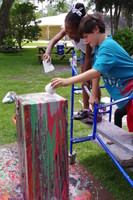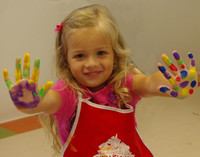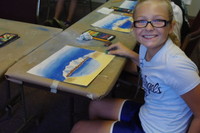As back-to-school time approaches, lazy days of summer become more and more precious. It's time to savor moments of playing in the sprinkler, throwing balls for the dog and chasing the ice cream truck. But children still have plenty of opportunities …
This item is available in full to subscribers.
Please log in to continue |



As back-to-school time approaches, lazy days of summer become more and more precious. It's time to savor moments of playing in the sprinkler, throwing balls for the dog and chasing the ice cream truck. But children still have plenty of opportunities for summer fun Coastal Arts Center of Orange Beach.
Instructor Belinda Butler said that the Wednesday Kid's Art Happenings are 9:30-11:30 a.m. weekly and offer students a creative outlet they can dig paint-splotched fingers into.
“Each week we study a different artist, do artwork in the style of that artist, and enjoy outdoor art activities,” she revealed. “On July 24, (we viewed) work by Alabama folk artist Mose T. and other primitive folk art. (Author) Karen (Thomason) (presented) Boat House Buddies book number four, “Artful Decision,” and we'll then do folk art paintings using sand as part of the paintings. On July 31, our artist will be Georgia O'Keefe.”
Children often immerse themselves in activities they enjoy during summer break, but Butler said they're doing much more than they may realize.
“Art enriches our lives in many ways, whether during the summer or during school months,” she explained. “Making art is a process involving a great deal of problem-solving: 'How do I get from here to there?' 'What are the steps?' 'In what order should I complete the steps in order to accomplish my desired result?' 'What materials do I use?' 'If I don't have those materials, and can't afford them or have no place to get them, what can I use instead?' Art isn't a frivolous distraction that entices students away from real learning. The arts teach skills that other basic subjects cannot: critical thinking and problem solving, judgment and independence, attention to detail and craftsmanship and an openness to other cultures and ways of thinking that helps us understand our own lives.”
Students are given the opportunity to find themselves as they hone their crafts.
“There is no one 'right' answer in art, a mirror of many life situations,” she divulged. “Even in the performing arts, where one is following the choreography, lines, or music that someone else may have written, each individual develops his or her own style.”
She said that written and visual art forms help children to search out knowledge inside themselves.
“I used to be an English teacher,” she said. “I liked teaching writing for some of the same reasons I like working with the children's programs here: writing is a process. When it's going well (and sometimes when it's not), one is actually learning what one thinks. I could never teach someone how to write 'the great American novel,' but I could give them the basic expository building blocks to communicate what they needed to communicate. I could facilitate their discovery of themselves and where they fit in the world around them. Making art does that, too.”
But Butler hopes Coastal Arts Center can offer enrichment beyond what children can find in the classroom.
“We have wonderful art teachers in our island schools, both elementary and in high school. However, their time with students is limited. Yvette Jones, elementary teacher, sees students at best every couple of weeks. Many of our elementary students (the ages I deal with most) are starving for ways to express themselves. They get very good instruction at school, but not enough of it and because of the circumstances of the environment, some activities are limited.”
She said she is happy to share lessons of knowledge and diversity with art students.
“Here at the Arts Center students experience acceptance and freedom within our class guidelines, learn basic art skills, e.g. we studied seven basic kinds of lines and ways to use them during our Walter Anderson lesson, learn to get along with kids of other ages from other schools and towns, learn to work as individuals and as part of a team — I could go on and on.”
The July 24th class featured Author Karen Thomason and the Boat House Buddies book, “Artful Decision.”
“The Boat House Buddies books are about individual resiliency and the individual as part of a group,” Butler explained. “They teach assessment of the situation, thinking outside the box, personal goal-setting, responsibility, commitment and community involvement. They fit well with my philosophy of Arts Education, and are just plain fun, too.”
And that last part sums up the entire art camp experience, she said.
“The fun part is perhaps something that's a bit different from 'regular' school: I have specific goals for each lesson, but sometimes we're able to do things just because they seem like they'd be fun — Yvette doesn't always have that luxury in the classroom. I'm an educator: I'm always reminding the kids of what they're learning. But they don't always care about that. They're just having fun.”
Many would agree that students learn best with engaging activities that hide multiple lessons behind a canvas or under a paintbrush.
“My favorite quote, which sums up why I think arts instruction is important, is from Charles B. Fowler's “Strong Arts, Strong Schools:” 'Joyous as it may be, the act of creating demands enormous self-discipline that teaches students to learn how to handle frustration and failure in pursuit of their idea. It requires setting goals, selecting a strategy, determining how to apply it, and continually making assessments and revisions — in other words, thinking and solving problems. It is the human mind operating at its very best.'”